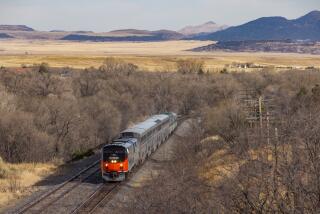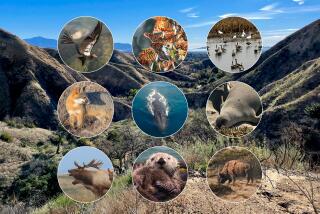Birds of the Bosque
BOSQUE DEL APACHE NATIONAL WILDLIFE REFUGE, N.M. â As I write this I am sitting in my truck, deep in the heart of New Mexicoâs Bosque del Apache National Wildlife Refuge. It is high noon and too bright to photograph. Outside, gangs of sandhill cranes move from one field to the next, their gurgling sounds causing me to stop typing and look up in wonder. The 4-foot-tall birds, with their long, graceful necks and super-long legs, sound as if they are underwater.
I marvel at the scene before me, then resume my writing. When I look up I see more than just cranes. There are snow geese feeding in the same fields, thousands of the white-and-black beauties. The birds make their way to this refuge from places farther north to escape the brutal cold and enjoy ample food. Sometimes a coyote saunters by, causing the anxious flock to scream and chatter and explode into the heavens. Seconds later I see the geese circle and land again, and all is quiet.
The Bosque (pronounced BOSS-kay, Spanish for woods) provides habitat for about 325 kinds of birds, including wild turkeys, and more than 135 other animals such as deer and bobcats. Although winter is a wonderful time to visit, different species are usually present at different times of year. Spring and fall visitors will see migrant warblers, shorebirds and flycatchers; summers are good for nesting ducks, shorebirds, songbirds and waders. Some animals, though--birds such as the Canada goose, coot, roadrunner, quail and turkey, as well as coyote, mule deer and porcupine--are present year-round.
But for bird-watchers, fall and winter are special times of the year, when between 30,000 and 40,000 snow geese and Rossâ geese make the Bosque their migratory home, joined by 12,000 to 17,000 sandhill cranes, about 66,000 ducks--including mallards, northern shovelers and pintails--a number of eagles and the rare and endangered whooping crane. The few whoopers seen here are members of an experimental group hatched and fostered at Grays Lake National Wildlife Refuge in Idaho.
The 57,000-acre Bosque del Apache National Wildlife Refuge was established in 1939, in part because the sandhill crane had nearly vanished from the Rio Grande region about 100 miles south of Albuquerque. It was set aside as a refuge and breeding ground for migratory birds and other wildlife.
The Bosque refuge is visually stunning. Lovely mountains nearly surround the Rio Grande Valley, from the Chupadera, Magdalena and San Mateo mountains that frame the valley to the west, to the Oscura and San Andreas ranges that stand like sentries in the east. To the south is the Fra Cristobal Range.
The name âBosque del Apacheâ is fitting considering the numerous cottonwood and willow woods that once lined the Rio Grande here, where Apaches used to come in hunting parties. Unfortunately, many of the native trees were killed off by an introduced species called salt cedar, also known as tamarisk. Today, refuge managers are clearing away the salt cedar in an attempt to restore native woods.
I visited the Bosque wildlife refuge two of the past three winters. Although I donât consider myself an avid birder, I do enjoy observing birds, and as a photojournalist, I love photographing them.
As I watched and listened to the birds, I couldnât help thinking that they seemed a lot like me. Like the birds, I usually head south in the winter, but in my case I pull along my home, a 30-foot fifth-wheel trailer.
During one weeklong visit to the Bosque two winters ago, I saw many wildlife spectacles. Great blue herons croaked and flew by, landing in a local drainage ditch, where they waited for their next meal of tiny fish. I saw a deer tiptoe out from behind the trees, take a sip from a nearby pond, then vanish.
One day, as the sun set and the temperature dropped dramatically, I aimed my camera, mounted with a 600-millimeter lens on a tripod, and clicked the shutter over and over again as thousands of newly arriving snow geese joined an already bulging crowd of geese. As if that werenât enough, sandhill cranes began to appear, flying low and alighting near the geese.
Several visitors stopped to watch the spectacle as the setting sun painted the birds a pastel pink. Soon the performance was over. Darkness fell upon the quiet waters, and I had to leave. But I knew Iâd be back the next day to witness the same.
Sometimes the winter weather was quite pleasant at the Bosque; in fact, I donned shorts on more than one occasion. But cold can attack here, and because the refuge is open an hour before sunrise, especially in the morning I was always prepared with several layers of clothes and a warm jacket.
During my second trip to the Bosque, I stayed warm by parking my trailer at the Bosque Bird Watcherâs RV park, a few minutes north of the refuge visitor center, just outside the refuge boundary. The RV hookups powered my two electric heaters and my microwave.
But on my first trip to the Bosque refuge, sans trailer, I drove my pickup and stayed in nearby Socorro, which is 18 miles to the north. Socorro is a friendly little town, named by Spanish explorer Juan de Onate, who with his troops journeyed through Jornado del Muerto (journey of death), the desert region southeast of Socorro. Today the region is part of the White Sands Missile Range. Socorro has a population of 8,500 and offers all the amenities of any small town. Thereâs a post office, an assortment of motels, numerous restaurants, a couple of grocery stores and stations providing gas and diesel.
I often left the birds for a while to zip into Socorro when I was hungry, indulging in my favorite fast foods at Taco Bell and KFC. But sometimes I didnât want to leave the area surrounding the refuge, so I bought groceries and cooked my next few meals in my RV, where I used my little combination stove/oven to cook and to heat up my trailer.
Because of the cold, I thoroughly enjoyed driving the gravel roads through the refuge while staying warm inside. On chilly mornings I ran my heater during the 15 miles of tour roads, looking for birds and other animals to photograph. Fortunately for me, I found that the best way to photograph birds and wildlife at the refuge was to stay inside my vehicle. I always drove slowly, stopped often and scanned the areas where animals were most likely to hide. I never made the full loop without seeing at least one exciting creature.
Once the day warmed up, several nature trails gave me a chance to stretch. But during the winter, I never saw the refuge get really crowded with people.
When I was walking, I did so slowly and quietly. Often I found animal tracks, feathers, scat and animals themselves. When I found a good spot for observing, I just sat down and blended in. I relaxed, closed my eyes and listened to the sounds of sandhill cranes gurgling, or the snow geese taking off en masse from a nearby field.
(BEGIN TEXT OF INFOBOX / INFOGRAPHIC)
GUIDEBOOK: For the Birds
How to get there: You can fly LAX to Albuquerque, N.M., on America West Airlines (with connections through Phoenix) or United Airlines (connecting through Denver) starting at $214 round trip. By car, itâs then a 96-mile drive south on Interstate 25 to the Bosque del Apache Wildlife Refuge. Take the San Antonio exit, head east to New Mexico 1 (at the flashing light), then go south for eight miles to the refuge.
The Bosque del Apache Wildlife Refuge, P.O. Box 1246, Socorro, NM 87801; telephone (505) 835-1828. The refuge is open year-round from one hour before sunrise to one hour after sunset. Admittance is $3 per vehicle. The visitor center is open 7:30 a.m.-4 p.m. weekdays and 8 a.m.-4:30 p.m. on weekends.
At the visitor center on Saturdays at 9 a.m., the refuge offers three-hour naturalist tours of birding areas; and Sundays at 1 p.m. there is a two-hour tour to explain the refugeâs research and environmental management. Transportation is provided and both tours are free, but reservations are required. You can also drive around the refuge on your own; the road covers about 15 miles.
Where to stay: On one trip I stayed at the Bosque Bird Watcherâs RV Park, 1481 NM Road 1, San Antonio, NM 87832 (or P.O. Box 262, Socorro, NM 87801), which is five miles north of the refuge visitor center. Owned and operated by the Trujillos family, it offers full electrical hookups. RV rates: $14.50-$16.50 daily, $70 weekly, $190 monthly. Tel. (505) 835-1366.
The town of Socorro is 18 miles north of the refuge, with an assortment of motels, including the Best Western Golden Manor Motel, 507 N. California St., Socorro, NM 87801. Room rates: $52-$78. Tel. 505-835-0230.
For more information: Socorro County Chamber of Commerce, P.O. Box 743-H, Socorro, NM 87801; tel. (505) 835-0424. New Mexico Department of Tourism, 491 Old Santa Fe Trail, Santa Fe, NM 87503; tel. (800) 545-2040, fax (505) 827-7402, Internet https://www.newmexico.org.
More to Read
Sign up for The Wild
Weâll help you find the best places to hike, bike and run, as well as the perfect silent spots for meditation and yoga.
You may occasionally receive promotional content from the Los Angeles Times.






